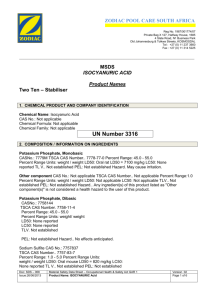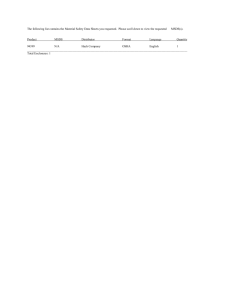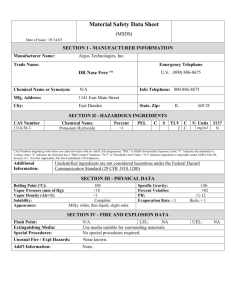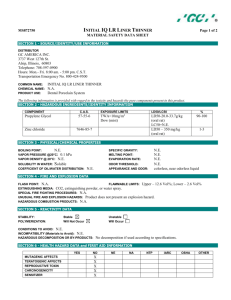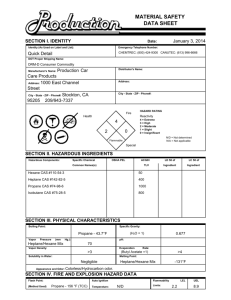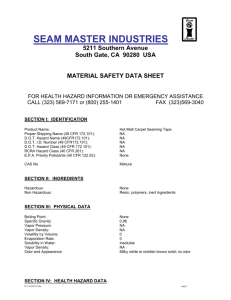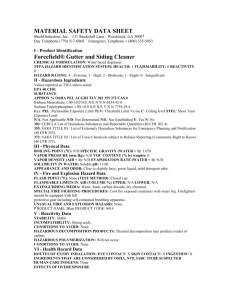Document 12823889
advertisement
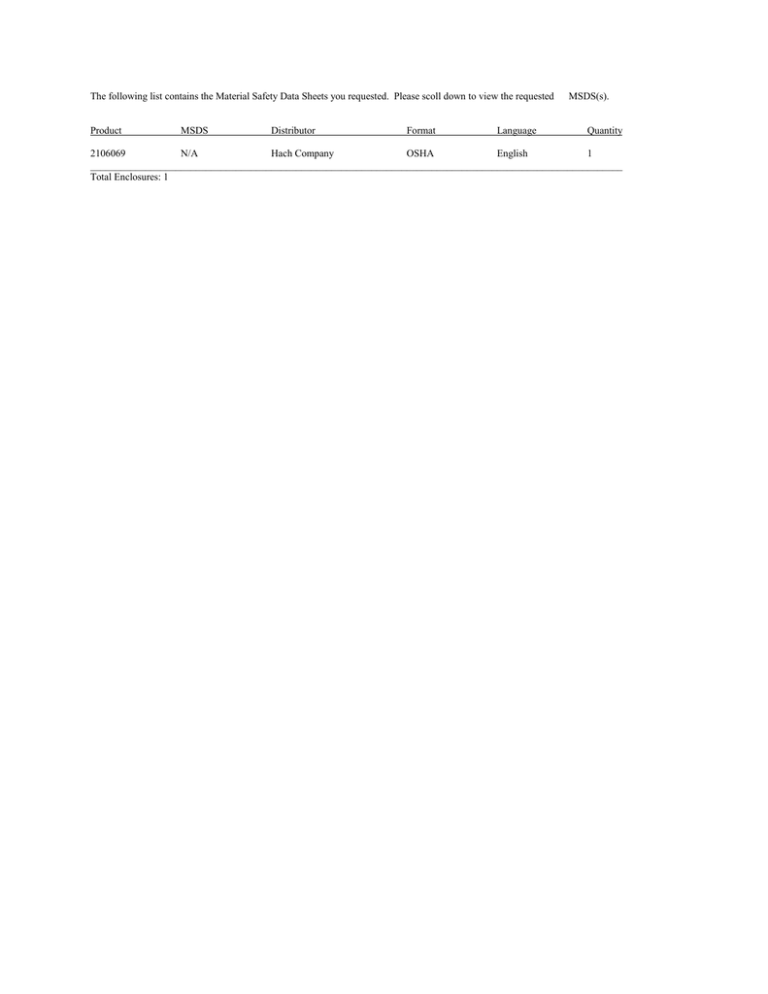
The following list contains the Material Safety Data Sheets you requested. Please scoll down to view the requested Product MSDS Distributor Format Language MSDS(s). Quantity 2106069 N/A Hach Company OSHA English 1 __________________________________________________________________________________________________________ Total Enclosures: 1 World Headquarters Hach Company P.O.Box 389 Loveland, CO USA 80539 (970) 669-3050 MSDS No: M00035 MATERIAL SAFETY DATA SHEET _____________________________________________________________________________ 1. CHEMICAL PRODUCT AND COMPANY IDENTIFICATION Product Name: PhosVer ® 3 Phosphate Reagent Catalog Number: 2106069 Hach Company P.O.Box 389 Loveland, CO USA 80539 (970) 669-3050 Emergency Telephone Numbers: (Medical and Transportation) (303) 623-5716 24 Hour Service (515)232-2533 8am - 4pm CST MSDS Number: M00035 Chemical Name: Not applicable CAS No.: Not applicable Chemical Formula: Not applicable Chemical Family: Not applicable Hazard: Causes eye burns. Date of MSDS Preparation: Day: 28 Month: June Year: 2011 _____________________________________________________________________________ 2. COMPOSITION / INFORMATION ON INGREDIENTS Potassium Pyrosulfate CAS No.: 7790-62-7 TSCA CAS Number: 7790-62-7 Percent Range: 75.0 - 85.0 Percent Range Units: weight / weight LD50: Oral rat LD50 = 2340 mg/kg LC50: None reported TLV: Not established PEL: Not established Hazard: Causes eye burns. Ascorbic Acid CAS No.: 50-81-7 TSCA CAS Number: 50-81-7 Percent Range: 15.0 - 25.0 Percent Range Units: weight / weight LD50: Oral rat LD50 = 11900 mg/kg LC50: None reported TLV: Not established PEL: Not established Hazard: Practically non-toxic. Sodium Molybdate CAS No.: 7631-95-0 TSCA CAS Number: 7631-95-0 Percent Range: 1.0 - 10.0 Percent Range Units: weight / weight LD50: Oral rat LD50 = 4000 mg/kg. LC50: Inhalation rat LC50 = > 2080 mg/m³/4 hrs TLV: 5 mg/m³ (as Mo) PEL: 5 mg/m³ (as Mo) Hazard: May cause irritation. Other components, each CAS No.: Not applicable TSCA CAS Number: Not applicable Percent Range: 1.0 - 10.0 Percent Range Units: weight / weight LD50: Not applicable LC50: Not applicable TLV: Not established PEL: Not established Hazard: Any ingredient(s) of this product listed as "Other component(s)" is not considered a health hazard to the user of this product. _____________________________________________________________________________ 3. HAZARDS IDENTIFICATION Emergency Overview: Appearance: White to off-white powder Odor: None CAUSES EYE BURNS MAY CAUSE RESPIRATORY TRACT IRRITATION HMIS: Health: 3 Flammability: 1 Reactivity: 0 Protective Equipment: X - See protective equipment, Section 8. NFPA: Health: 3 Flammability: 1 Reactivity: 0 Symbol: Not applicable Potential Health Effects: Eye Contact: Causes eye burns. Skin Contact: No effects are anticipated Skin Absorption: None reported Target Organs: None reported Ingestion: May cause: copper deficiency anemia gout loss of appetite loss of coordination listlessness diarrhea liver damage May effect enzyme activity. Target Organs: Blood Liver Inhalation: May cause: respiratory tract irritation Effects similar to those of ingestion. Target Organs: Blood Liver Medical Conditions Aggravated: Pre-existing: Eye conditions Respiratory conditions Gout Chronic Effects: Chronic overexposure may cause copper deficiency enzyme activity effects liver damage Molybdenum poisoning signs include loss of appetite, listlessness and reduced growth rate. Excessive exposure to molybdenum compounds may cause gout and anemia. Cancer / Reproductive Toxicity Information: This product does NOT contain any OSHA listed carcinogens. This product does NOT contain any IARC listed chemicals. This product does NOT contain any NTP listed chemicals. Additional Cancer / Reproductive Toxicity Information: Contains: an experimental mutagen. Toxicologically Synergistic Products: None reported _____________________________________________________________________________ 4. FIRST AID Eye Contact: Immediately flush eyes with water for 15 minutes. Call physician. Skin Contact (First Aid): Wash skin with plenty of water. Ingestion (First Aid): Do not induce vomiting. Give 1-2 glasses of water. Call physician immediately. Never give anything by mouth to an unconscious person. Inhalation: Remove to fresh air. Give artificial respiration if necessary. Call physician. _____________________________________________________________________________ 5. FIRE FIGHTING MEASURES Flammable Properties: Can burn in fire, releasing toxic vapors. Flash Point: Not applicable Method: Not applicable Flammability Limits: Lower Explosion Limits: Not applicable Upper Explosion Limits: Not applicable Autoignition Temperature: Not determined Hazardous Combustion Products: Toxic fumes of: sulfur oxides. carbon monoxide, carbon dioxide. sodium monoxide Fire / Explosion Hazards: None reported Static Discharge: None reported. Mechanical Impact: None reported Extinguishing Media: Use media appropriate to surrounding fire conditions Fire Fighting Instruction: As in any fire, wear self-contained breathing apparatus pressure-demand and full protective gear. _____________________________________________________________________________ 6. ACCIDENTAL RELEASE MEASURES Spill Response Notice: Only persons properly qualified to respond to an emergency involving hazardous substances may respond to a spill according to federal regulations (OSHA 29 CFR 1910.120(a)(v)) and per your company's emergency response plan and guidelines/procedures. See Section 13, Special Instructions for disposal assistance. Outside of the US, only persons properly qualified according to state or local regulations should respond to a spill involving chemicals. Containment Technique: Stop spilled material from being released to the environment. Clean-up Technique: Scoop up spilled material into a large beaker and dissolve with water. Adjust to a pH between 6 and 9 with an alkali, such as soda ash or sodium bicarbonate. Flush reacted material to the drain with a large excess of water. Decontaminate the area of the spill with a soap solution. Evacuation Procedure: Evacuate local area (15 foot radius or as directed by your facility's emergency response plan) when: any quantity is spilled. Special Instructions (for accidental release): Not applicable 304 EHS RQ (40 CFR 355): Not applicable D.O.T. Emergency Response Guide Number: None _____________________________________________________________________________ 7. HANDLING / STORAGE Handling: Avoid contact with eyes Do not breathe dust. Wash thoroughly after handling. Maintain general industrial hygiene practices when using this product. Storage: Store between 10° and 25°C. Flammability Class: Not applicable _____________________________________________________________________________ 8. EXPOSURE CONTROLS / PROTECTIVE EQUIPMENT Engineering Controls: Maintain general industrial hygiene practices when using this product. Personal Protective Equipment: Eye Protection: safety glasses with top and side shields Skin Protection: disposable latex gloves In the EU, the selected gloves must satisfy the specifications of EU Directive 89/686/EEC and standard EN 374 derived from it. lab coat Inhalation Protection: adequate ventilation Precautionary Measures: Avoid contact with: eyes Do not breathe: dust Wash thoroughly after handling. TLV: Not established PEL: Not established _____________________________________________________________________________ 9. PHYSICAL / CHEMICAL PROPERTIES Appearance: White to off-white powder Physical State: Solid Molecular Weight: Not applicable Odor: None pH: of a 5% solution = 1.5 Vapor Pressure: Not applicable Vapor Density (air = 1): Not applicable Boiling Point: Not applicable Melting Point: 105 °C (221 °F) Specific Gravity/ Relative Density (water = 1; air =1): 2.22 Evaporation Rate (water = 1): Not applicable Volatile Organic Compounds Content: Not applicable Partition Coefficient (n-octanol / water): Not applicable Solubility: Water: Soluble Acid: Soluble Other: Not determined Metal Corrosivity: Steel: Not applicable Aluminum: Not applicable _____________________________________________________________________________ 10. STABILITY / REACTIVITY Chemical Stability: Stable when stored under proper conditions. Conditions to Avoid: Extreme temperatures Reactivity / Incompatibility: Incompatible with: oxidizers dyes alkalies iron copper Hazardous Decomposition: Heating to decomposition releases: carbon dioxide carbon monoxide sulfur oxides Hazardous Polymerization: Will not occur. _____________________________________________________________________________ 11. TOXICOLOGICAL INFORMATION Product Toxicological Data: LD50: None reported LC50: None reported Dermal Toxicity Data: None reported Skin and Eye Irritation Data: Not corrosive to skin, no erythema Mutation Data: None reported Reproductive Effects Data: None reported Ingredient Toxicological Data: Potassium Pyrosulfate Oral rat LD50 = 2340 mg/kg; Sodium Molybdate Oral rat LD50 = 4000 mg/kg, Inhalation rat LC50 > 2080mg/m3/4 hr; Ascorbic Acid Oral rat LD50 = 11.9 g/kg _____________________________________________________________________________ 12. ECOLOGICAL INFORMATION Product Ecological Information: -No ecological data available for this product. Mobility in soil: No data available Ingredient Ecological Information: -Ecological data for ingredients is not indicative of likely ecological harm. _____________________________________________________________________________ 13. DISPOSAL CONSIDERATIONS EPA Waste ID Number: None Special Instructions (Disposal): Work in an approved fume hood. Dilute material with excess water making a weaker than 5% solution. Adjust to a pH between 6 and 9 with an alkali, such as soda ash or sodium bicarbonate. Open cold water tap completely, slowly pour the reacted material to the drain. Allow cold water to run for 5 minutes to completely flush the system. Empty Containers: Rinse three times with an appropriate solvent. Dispose of empty container as normal trash. NOTICE (Disposal): These disposal guidelines are based on federal regulations and may be superseded by more stringent state or local requirements. Please consult your local environmental regulators for more information. _____________________________________________________________________________ 14. TRANSPORT INFORMATION D.O.T.: D.O.T. Proper Shipping Name: Not Currently Regulated -DOT Hazard Class: NA DOT Subsidiary Risk: NA DOT ID Number: NA DOT Packing Group: NA I.C.A.O.: I.C.A.O. Proper Shipping Name: Not Currently Regulated -ICAO Hazard Class: NA ICAO Subsidiary Risk: NA ICAO ID Number: NA ICAO Packing Group: NA I.M.O.: I.M.O. Proper Shipping Name: Not Currently Regulated -I.M.O. Hazard Class: NA I.M.O. Subsidiary Risk: NA I.M.O. ID Number: NA I.M.O. Packing Group: NA Additional Information: There is a possibility that this product could be contained in a reagent set or kit composed of various compatible dangerous goods. If the item is NOT in a set or kit, the classification given above applies. If the item IS part of a set or kit, the classification would change to the following: UN3316 Chemical Kit, Class 9, PG II or III. If the item is not regulated, the Chemical Kit classification does not apply. _____________________________________________________________________________ 15. REGULATORY INFORMATION U.S. Federal Regulations: O.S.H.A.: This product meets the criteria for a hazardous substance as defined in the Hazard Communication Standard. (29 CFR 1910.1200) E.P.A.: S.A.R.A. Title III Section 311/312 Categorization (40 CFR 370): Immediate (Acute) Health Hazard Delayed (Chronic) Health Hazard S.A.R.A. Title III Section 313 (40 CFR 372): This product does NOT contain any chemical subject to the reporting requirements of Section 313 of Title III of SARA. -302 (EHS) TPQ (40 CFR 355): Not applicable 304 CERCLA RQ (40 CFR 302.4): Not applicable 304 EHS RQ (40 CFR 355): Not applicable Clean Water Act (40 CFR 116.4): Not applicable RCRA: Contains no RCRA regulated substances. C.P.S.C.: Not applicable State Regulations: California Prop. 65: No Prop. 65 listed chemicals are present in this product. Identification of Prop. 65 Ingredient(s): None California Perchlorate Rule CCR Title 22 Chap 33: Not applicable Trade Secret Registry: Not applicable National Inventories: U.S. Inventory Status: All ingredients in this product are listed on the TSCA 8(b) Inventory (40 CFR 710). TSCA CAS Number: Not applicable _____________________________________________________________________________ 16. OTHER INFORMATION Intended Use: Laboratory Use Phosphate determination References: TLV's Threshold Limit Values and Biological Exposure Indices for 1992-1993. American Conference of Governmental Industrial Hygienists, 1992. Air Contaminants, Federal Register, Vol. 54, No. 12. Thursday, January 19, 1989. pp. 2332-2983. In-house information. Technical Judgment. Outside Testing. NIOSH/OSHA Occupational Health Guidelines for Chemical Hazards. Cincinnati: Department of Health and Human Services, 1981. Sax, N. Irving. Dangerous Properties of Industrial Materials, 7th Ed. New York: Van Nostrand Reinhold Co., 1989. Gosselin, R. E. et al. Clinical Toxicology of Commercial Products, 5th Ed. Baltimore: The Williams and Wilkins Co., 1984. Vendor Information. Patty, Frank A. Industrial Hygiene and Toxicology, 3rd Revised Edition. Volume 2. New York: A WileyInterscience Publication, 1981. Revision Summary: Substantial revision to comply with EU Reg 1272/2008, Reg 1907/2006 and UN GHS ( ST/SG/AC.10/36/Add.3). _____________________________________________________________________________ Legend: NA - Not Applicable ND - Not Determined NV - Not Available w/w - weight/weight w/v - weight/volume v/v - volume/volume USER RESPONSIBILITY: Each user should read and understand this information and incorporate it in individual site safety programs in accordance with applicable hazard communication standards and regulations. THE INFORMATION CONTAINED HEREIN IS BASED ON DATA CONSIDERED TO BE ACCURATE. HOWEVER, NO WARRANTY IS EXPRESSED OR IMPLIED REGARDING THE ACCURACY OF THESE DATA OR THE RESULTS TO BE OBTAINED FROM THE USE THEREOF. HACH COMPANY ©2012
